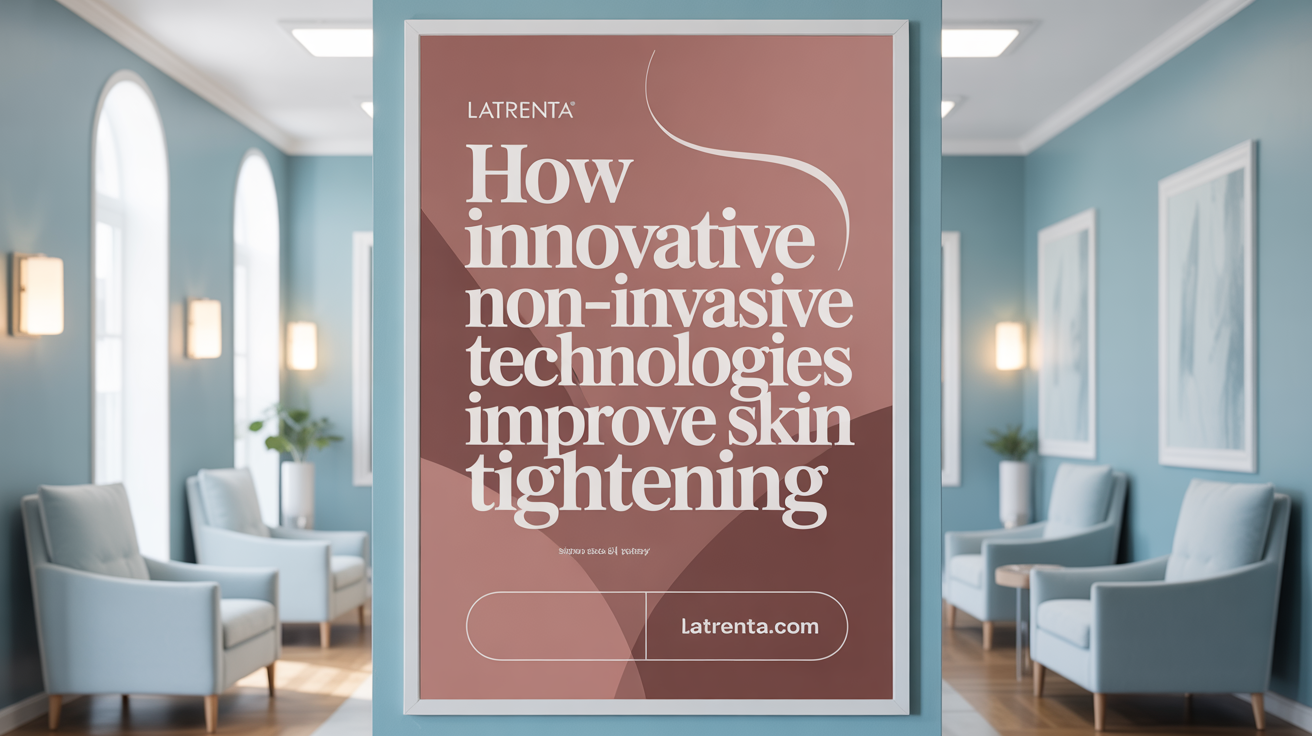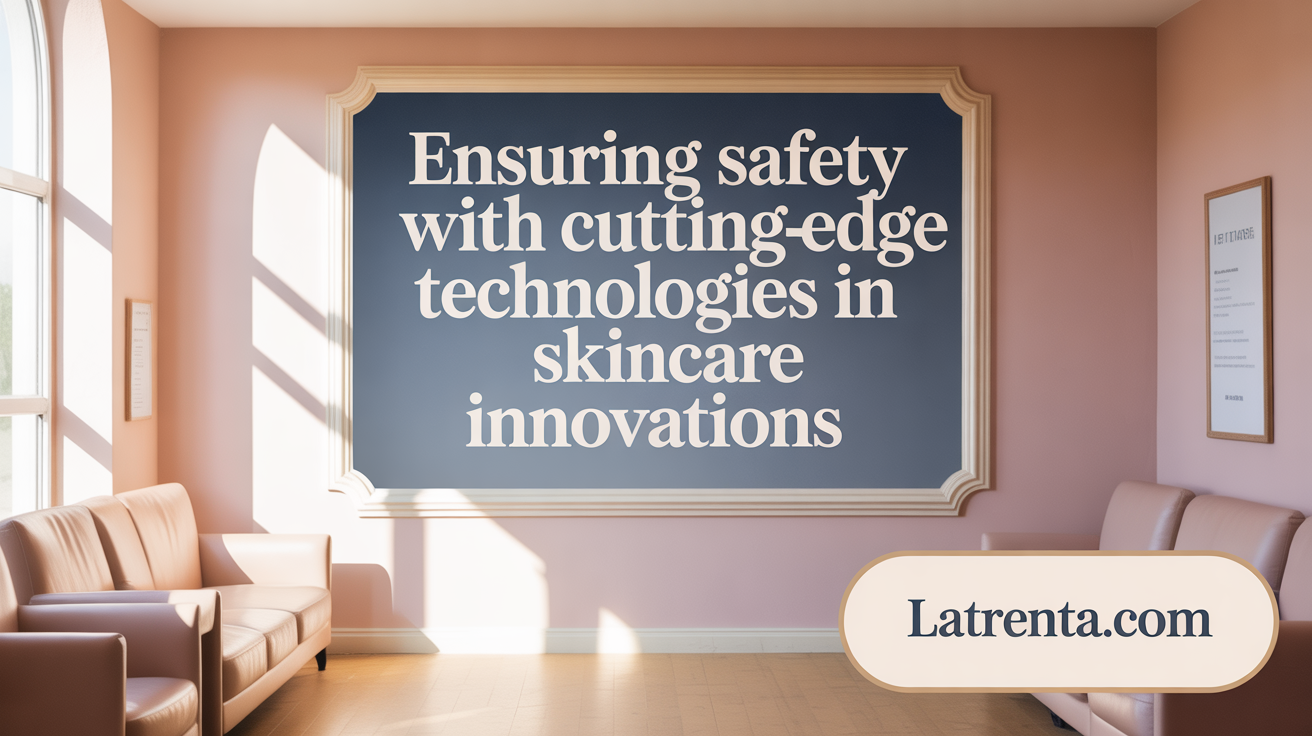Introduction to Non-Surgical Skin Tightening
With aging, the natural decline of collagen and elastin leads to skin laxity, prompting many to seek effective skin tightening without surgery. In 2025, non-invasive treatments have evolved significantly, offering promising alternatives to surgical procedures. This article explores the most effective skin tightening options available, supported by scientific data, safety considerations, and market trends shaping the future of aesthetic dermatology.
Overview of Leading Non-Surgical Skin Tightening Procedures in 2025

What are the best non-surgical skin tightening procedures available in 2025?
In 2025, the most advanced non-invasive treatments for skin tightening include FaceTite Turbo, RF-based therapies, ultrasound methods such as Ultherapy, laser skin tightening, Morpheus8, and innovative technologies like Morpheus8 and MultiFrax. These procedures are designed to stimulate the skin’s natural proteins—collagen and elastin—that decline with age, helping to lift, tighten, and rejuvenate the skin without the need for surgical intervention.
Popular non-invasive treatments in 2025
Non-invasive options have gained significant popularity due to their safety, minimal downtime, and impressive results. Treatments like Ultherapy are FDA-cleared for lifting the brow and jawline, primarily targeting moderate skin laxity. Laser skin tightening, especially effective for fine lines and delicate areas like around the eyes and neck, offers precise and gentle rejuvenation.
HIFU (High-Intensity Focused Ultrasound) penetrates deeper into the skin layers, providing a non-surgical facelift effect by contracting deeper tissues. Additionally, microneedling combined with RF delivers effective results for deep wrinkles, scars, and significant skin laxity.
In-office devices such as SOFWAVE, Morpheus8, and MultiFrax are increasingly used for subtle to moderate tightening. These treatments often require several sessions, with visible improvements typically appearing within 2-4 weeks, and results gradually improving over several months.
Effectiveness of FaceTite Turbo, RF, ultrasound therapies
These treatments vary in their depth and targeting capabilities. RF therapies are particularly effective for skin tightening, promoting collagen growth with 30% or more improvement in some cases. Ultherapy and HIFU focus on deeper tissues, offering more profound lifting effects.
EmbraceRF combines FaceTite and Morpheus8, offering a comprehensive lift and contour for those seeking a non-surgical facelift alternative. Technologies like QuantumRF and IgniteRF utilize fractionated radiofrequency to target deep tissue layers, enhancing skin contraction and firmness.
Studies employing AI-based skin analysis validate these treatments' effectiveness, showing significant improvements in skin firmness and wrinkle reduction that correlate with human assessments.
Treatment areas and patient suitability
Ideal areas for non-surgical skin tightening include the face—particularly the jawline, neck, brow, and cheeks—as well as body regions like the arms and thighs. Most treatments are suitable for adults experiencing mild to moderate skin laxity, typically in their 30s to 50s, although some procedures can benefit older individuals with more pronounced sagging.
Patients with realistic expectations, mild to moderate laxity, and no contraindications to energy-based treatments are appropriate candidates. Those seeking a non-invasive alternative to surgery often prefer these procedures, especially when minimal downtime is a priority.
| Treatment Technology | Common Use Cases | Recommended Age Range | Effect Duration | Downtime |
|---|---|---|---|---|
| RF Therapy | Face, body | 30s-50s | 1-3 years | Minimal, 1-2 days |
| Ultherapy | Brow, jawline | 30s-40s | 1 year+ | None to slight redness |
| HIFU | Full face, neck | 40s-50s | 1-2 years | None |
| Morpheus8 | Face, neck, scars | 30s-60s | 1-3 years | Minimal |
| MultiFrax | Face, body | 30s-50s | 1-2 years | Mild redness for 1-2 days |
These treatment options continue to evolve, integrating AI and improved device technologies, promising even better results in the near future.
Mechanisms Behind Non-Invasive Skin Tightening Treatments

How do various non-surgical skin tightening treatments work?
Non-invasive skin tightening procedures primarily rely on delivering controlled energy sources to the deeper layers of the skin. These energy types include radiofrequency (RF), ultrasound, and laser or plasma-based technologies, each designed to stimulate the body's natural collagen and elastin production.
The process begins with the targeted heating of skin tissues. For example, RF devices generate thermal energy that penetrates into the dermis, causing immediate collagen fiber contraction. Ultrasound-based treatments like Ultherapy use focused ultrasound waves to reach deeper layers, lifting and firming the skin.
Laser skin tightening employs specific wavelengths that stimulate collagen remodeling by heating superficial layers, which is especially effective for fine lines and mild sagging.
The thermal effects set off a cascade of healing responses, including the stimulation of fibroblasts—the cells responsible for collagen creation. This process boosts new collagen synthesis, which gradually improves skin texture, elasticity, and firmness.
Most treatments induce only minor discomfort and require little to no downtime. Multiple sessions might be necessary for optimal results, which typically become visible within a few weeks and can last for over a year.
As technology advances, the combination of these energy sources and the integration of AI-based assessment tools help optimize treatment efficacy, ensuring patients receive personalized, effective skin rejuvenation with minimal risks.
How Thermal Effects Impact Skin Layers
Thermal energy intentionally heats specific skin layers, mainly the dermis, to stimulate tissue contraction and collagen production. This controlled heating causes immediate tightening of collagen fibers and triggers cellular responses that lead to production of new collagen over subsequent months.
Deeper heating, as achieved by ultrasound (e.g., HIFU), affects the superficial fascia and subdermal tissue, providing a lifting effect. RF and laser treatments target superficial dermal layers, improving skin texture and reducing fine lines.
Thermal effects also promote neocollagenesis, the process of new collagen formation, which results in longer-lasting improvements in skin laxity and resilience.
Process of Collagen Remodeling and Skin Firming
Collagen remodeling is central to skin tightening. After thermal stimulation, collagen fibers contract immediately, providing an instant tightening sensation.
Over time, heat induces fibroblasts to produce new collagen, which replaces aging or damaged fibers. This process improves skin’s structural integrity.
Repeated treatments reinforce this remodeling, leading to sustained firmness and a more youthful appearance.
As collagen accumulates and reorganizes, skin appears smoother, firmer, and better able to resist gravity. This natural, gradual process minimizes the need for invasive surgery, providing a safe and effective alternative for patients seeking non-surgical rejuvenation.
Scientific Evidence Supporting Non-Surgical Skin Tightening Efficacy
 Numerous scientific studies and FDA trials have validated the effectiveness of non-surgical skin tightening treatments, making them popular choices for individuals seeking facial rejuvenation without surgery.
Numerous scientific studies and FDA trials have validated the effectiveness of non-surgical skin tightening treatments, making them popular choices for individuals seeking facial rejuvenation without surgery.
Clinical research shows that technologies such as microfocused ultrasound (MFU), radiofrequency (RF), laser therapies, and high-intensity focused ultrasound (HIFU) produce measurable improvements. For instance, MFU treatments have demonstrated significant lifting effects, with over 80% of patients experiencing noticeable results. Clinical data report eyebrow elevation averaging about 1.7 mm, along with improved skin firmness, texture, and elasticity.
Radiofrequency and laser therapies work by inducing controlled dermal heating, stimulating collagen and elastin production, which gradually tightens and smoothens the skin. These procedures typically result in visible skin enhancement within 2 to 4 weeks, with continued improvement over several months.
FDA approvals support these outcomes, with Ultherapy being FDA-cleared for lifting the brow and jawline areas. Similarly, laser skin tightening has gained acceptance for treating fine lines and mild sagging, especially around delicate areas like the eyes and neck.
Effectiveness percentages vary, but many treatments achieve high patient satisfaction. For example, surveys indicate that a significant portion of patients report noticeable lifting, volume restoration, and aesthetic improvement after non-invasive procedures. Side effects are generally mild and transient, such as redness or swelling that resolves within a day or two.
In summary, the growing body of evidence confirms that non-surgical skin tightening options are safe, effective, and capable of producing noticeable skin improvements, supported by robust clinical trials and regulatory endorsements.
Comparative Analysis of Non-Invasive Skin Tightening Technologies
Different non-invasive skin tightening methods utilize diverse energy sources to stimulate collagen production and improve skin firmness. These include radiofrequency (RF), ultrasound, laser, and plasma or micro-coring technologies, each with distinct mechanisms.
Radiofrequency (RF) therapy heats the dermis to stimulate collagen contraction and neocollagenesis. RF is widely available, effective for mild to moderate laxity, and usually involves minimal discomfort and downtime. Ultherapy, which employs ultrasound energy, targets deeper tissue layers to provide a lifting effect, especially beneficial for the jawline and brow. Its safety profile is well-established, and results typically develop over several weeks.
Laser skin tightening, utilizing lasers like Fraxel Resurface or CO2 technology, primarily addresses fine lines and superficial skin laxity. These treatments are suitable for delicate areas like the eyes and neck. They promote collagen renewal with a slightly higher risk of redness or irritation that usually subsides in a few days.
HIFU (High-Intensity Focused Ultrasound) penetrates deeper than RF or laser, delivering targeted energy to induce significant skin tightening with minimal invasiveness. It’s often used as a non-surgical facelift alternative, delivering noticeable results with a good safety record.
Plasma or micro-coring devices like Ellacor remove micro-amounts of skin tissue, stimulating collagen for wrinkle and laxity reduction with minimal surface damage. These are newer options offering promising results, especially for subtle skin rejuvenation.
Efficacy and safety profiles vary among these technologies. While all are considered safe when performed by trained professionals, mild side effects such as redness, swelling, or slight discomfort are common. Serious adverse effects are rare.
Choosing the right treatment depends heavily on individual patient needs and expectations. For mild sagging, laser treatments or RF might suffice. Deeper laxity may benefit from ultrasound (Ultherapy or HIFU), while micro-coring options like Ellacor suit those seeking minimal downtime and subtle improvements.
Most treatments deliver visible results within a few weeks, with improvements continuing over several months. Their favorable safety profiles and minimal downtime make them attractive options for those seeking skin tightening without surgery.
| Technology | Application | Depth of Penetration | Typical Results Timeline | Suitability | Additional Notes |
|---|---|---|---|---|---|
| RF | Skin tightening | Superficial to mid-dermis | 2-4 weeks to see improvements | Mild to moderate laxity | Widely available, customizable |
| Ultherapy | Lifting and tightening | Deep dermis to superficial muscle | 2-3 months | Moderate to severe laxity | FDA-cleared, non-invasive |
| Laser (Fraxel, CO2) | Texture and fine lines | Superficial | 1-3 months | Early aging signs, delicate areas | May cause redness, skin sensitivity |
| HIFU | Face lift effect | Deep tissue layers | 2-3 months | Sagging skin, mid to severe laxity | Good for non-surgical facelift |
| Micro-coring (Ellacor) | Wrinkle and laxity reduction | Superficial | Immediate, with ongoing collagen stimulation | Mild to moderate laxity | Minimal invasiveness, new technology |
Selecting the ideal skin tightening approach involves assessing skin laxity severity, skin type, and patient goals. Consulting with a qualified aesthetic professional ensures a tailored, effective treatment plan.
Recent Innovations Advancing Non-Surgical Skin Tightening

What recent advancements have been made in non-surgical skin tightening procedures?
In recent years, the field of non-invasive skin tightening has seen significant progress with the introduction of advanced devices and novel combination therapies. These innovations aim to enhance treatment efficacy, comfort, and natural results.
One notable development involves the use of precise energy delivery systems. For example, devices like EVERESSE utilize monopolar radiofrequency (RF) with water cooling. This technology improves patient comfort during treatments while effectively stimulating collagen production. RF microneedling platforms, such as VirtueRF, combine the benefits of microneedling and RF energy, deepening collagen stimulation and promoting skin firmness.
Ultrasound-based systems, including Sofwave and Ultherapy, continue to be popular, leveraging high-frequency ultrasound to target deep tissue layers. Ultherapy, in particular, is FDA-cleared for lifting the brow and jawline, with results gradually developing over several months.
A breakthrough innovation is Ellacor, which employs micro-coring technology. This technique involves removing micro-amounts of skin tissue to stimulate the body's natural collagen and elastin production. It effectively reduces sagging and fine lines with minimal invasiveness.
Combination therapies offer multi-faceted skin rejuvenation. For example, EmbraceRF merges FaceTite and Morpheus8, combining laser and radiofrequency energy to lift, contour, and tighten the skin as an alternative to surgery. These combined approaches deliver synergistic effects, improving outcomes while maintaining shorter recovery times.
Advancements also focus on increasing treatment precision and patient comfort. Technologies like high-frequency ultrasound and AI integration allow for tailored treatments and objective assessment of results. AI-based skin analysis can evaluate wrinkle reduction and skin firmness with high accuracy, guiding clinicians and patients in measuring treatment success.
Overall, ongoing innovations in non-surgical skin tightening are changing the landscape. They offer safer, more effective options with minimal downtime, making skin rejuvenation more accessible and natural-looking than ever before.
Safety Profiles and Technological Developments in Skin Tightening Treatments

What are the key safety considerations and technological developments in non-invasive skin tightening treatments?
Non-invasive skin tightening treatments have become increasingly popular due to their effectiveness and minimal downtime. Nonetheless, safety remains a crucial aspect. The primary safety consideration involves avoiding skin burns and thermal injuries. This risk is mitigated by using devices that are approved by the Food and Drug Administration (FDA) and by ensuring treatments are performed by trained, experienced providers.
Most patients experience mild, temporary side effects such as redness, swelling, or discomfort, which typically resolve within a day or two. Serious adverse effects are rare when protocols are followed properly, making these treatments a safe option for many skin types and ages.
Technological advances have propelled the safety and effectiveness of non-invasive skin tightening. Modern devices feature sophisticated temperature monitoring and real-time feedback systems. For example, high-frequency ultrasound (HIFU) and radiofrequency (RF) technologies now incorporate controlled energy delivery mechanisms that precisely target deep skin layers, stimulating collagen without damaging the surface.
Additional innovations include device designs that use AI-driven monitoring and adaptive energy delivery, which help optimize treatment parameters for individual patients. This reduces variability and enhances safety by preventing excessive thermal exposure.
Many devices also utilize safety features such as automated shut-offs if temperatures exceed safe limits. These features are supported by extensive clinical studies demonstrating their low complication rates.
Overall, continuous improvements in device technology—including better temperature control, targeted energy focusing, and real-time response—have greatly enhanced the safety profile of non-invasive skin tightening. When performed by qualified practitioners, these procedures offer a safe, effective way to rejuvenate the skin with minimal risk.
The combination of innovative technology and strict adherence to safety guidelines ensures that patients can enjoy results with confidence, making non-invasive skin tightening treatments a reliable option for skin rejuvenation in 2025.
Understanding Benefits and Suitability of Various Non-Surgical Options
What are the benefits and suitability criteria of various non-surgical skin tightening options?
Non-invasive skin tightening treatments have become increasingly popular as a safe and effective way to combat the signs of aging without the need for surgery. These treatments offer several advantages, including minimal downtime, absence of scarring, and the potential for gradual improvements in skin firmness and texture.
Most procedures work by stimulating the body's collagen and elastin production, the proteins responsible for maintaining skin elasticity and tightness. Technologies such as ultrasound (Ultherapy), radiofrequency (RF), laser, and intense pulsed light (IPL) are commonly used.
Benefits include versatility, allowing treatment of various areas like the face, neck, and other body regions. Patients typically experience little to no recovery time, with some minor redness or swelling resolving within 1-2 days. Results usually become visible within 2-4 weeks and continue to improve over several months.
Suitability depends on individual factors such as age, skin laxity level, and overall health. These treatments are ideal for those with mild to moderate skin sagging who want to avoid surgery, prefer quick recovery, or seek maintenance of youthful appearance. They are especially suitable for younger adults in their 30s to 50s who notice early signs of aging.
However, for individuals with significant skin laxity or severe sagging, surgical options like facelifts or body lifts may be more appropriate. These provide more immediate and long-lasting results but involve longer recovery periods.
Personal goals, budget, and the desired duration of results also influence choice. Consulting a skilled practitioner helps determine the most suitable treatment based on individual needs.
Overall, non-surgical skin tightening options provide a safe, effective, and customizable way to maintain skin firmness and combat early signs of aging, with ongoing innovations promising even better outcomes in the future.
Market Trends and Growth in Non-Invasive Skin Tightening
The market for non-invasive skin tightening procedures is experiencing substantial expansion, driven by technological advances and shifting consumer preferences. In 2024, this segment was valued at approximately USD 74 billion, and projections indicate it will grow to around USD 238 billion by 2034, reflecting a compound annual growth rate (CAGR) of approximately 12.4%. This rapid growth underscores the increasing demand for non-surgical options to improve skin laxity and overall facial appearance.
A significant factor contributing to this upward trend is the dominance of injectables such as botulinum toxin and dermal fillers. These treatments are increasingly preferred for their immediate results and minimal downtime. It is estimated that over 3 million botulinum toxin injections will be administered annually worldwide, highlighting their popularity as non-invasive facial enhancement tools.
Social media influence and improved acceptance of aesthetic procedures are also fueling the market. Positive testimonials, before-and-after pictures, and celebrity endorsements have made non-invasive treatments more accessible and acceptable across various age groups. This social shift encourages more individuals to pursue aesthetic improvements without surgery.
Furthermore, advancements like high-frequency ultrasound (such as Ultherapy) and AI integration in skin analysis have enhanced treatment efficacy, boosting consumer confidence. In-office options like Morpheus8, Sofwave, and combined treatments are gaining popularity, offering more nuanced and customizable solutions.
In summary, the broad acceptance and technological developments are turning non-invasive skin tightening into a significant and rapidly growing sector within aesthetic medicine. This trend is expected to continue, with innovations further improving results and patient satisfaction.
In-Office Technologies Gaining Traction in 2025
In 2025, several innovative in-office treatments are making waves in skin tightening and facial rejuvenation. Technologies like SOFWAVE, PRX DERM PERFEXION, and Morpheus8 are increasingly popular due to their effectiveness in addressing subtle to moderate skin laxity without the need for surgery.
SOFWAVE uses high-frequency ultrasound energy to stimulate collagen production, tightening skin gradually. PRX DERM PERFEXION is a transdermal biosynergy peeling treatment that tightens and rejuvenates skin with minimal downtime, suitable for delicate areas such as the eyes and neck.
Morpheus8 combines microneedling with radiofrequency energy, penetrating deep into the skin to stimulate collagen and elastin. This technology is highly effective for deep wrinkles, scars, and significant skin laxity.
Besides standalone devices, combination therapies like CoolTone and EMSCULPT NEO are gaining popularity. These treatments use electrical and RF energy to tone muscles and tighten skin, providing a non-surgical facelift effect with minimal recovery time.
Many of these treatments hold FDA approval or are used off-label based on clinical evidence. For example, Morpheus8 and CoolTone are FDA-approved, offering reassurance regarding safety and efficacy.
Overall, the trend towards minimally invasive treatments continues to grow, driven by advancements in energy-based technology and increasing patient demand for effective, low-risk options for skin tightening.
| Technology | Methodology | Suitable For | Additional Notes |
|---|---|---|---|
| SOFWAVE | Ultrasound energy | Mild to moderate laxity | Gradual tightening, minimal downtime |
| PRX DERM PERFEXION | Transdermal peeling with biosynergy tech | Delicate areas, early aging signs | Rejuvenation with minimal recovery |
| Morpheus8 | Microneedling + RF | Deep wrinkles, scars | Deep skin penetration for significant results |
| CoolTone, EMSCULPT NEO | Electromagnetic pulse + RF energy | Body contouring + skin tightening | Non-invasive with muscle stimulation benefits |
These advancements signify an ongoing shift towards non-surgical options that deliver meaningful results with fewer risks and less downtime, catering to the increasing demand for convenience and effectiveness in facial skin tightening.
AI and Objective Assessment of Treatment Outcomes
How is AI used in skin analysis after treatment?
AI-based skin analysis involves sophisticated imaging technology that objectively evaluates changes in skin quality and firmness following non-invasive procedures like HIFU and RF therapy. This technology captures high-resolution images, which AI algorithms analyze to assess improvements in wrinkle appearance and skin elasticity. These assessments provide quantifiable data, enabling practitioners to monitor patient progress accurately.
How well does AI correlate with traditional clinical assessments?
Research indicates that AI evaluations strongly correspond with clinician observations. Studies show high agreement levels between AI scores and expert ratings, with Cohen’s kappa values ranging from 0.72 to 0.91—signifying excellent consistency. This alignment confirms that AI can reliably mirror human judgment in assessing treatment results.
How can AI improve predictions of patient outcomes?
AI models enhance the ability to forecast treatment success by analyzing pre- and post-treatment skin conditions. In recent studies, AI scores not only detected immediate improvements but also forecasted sustained results at two months, with prediction accuracy reaching an Area Under the Curve (AUC) of up to 0.93. This predictive power helps clinicians tailor treatments more effectively, ensuring higher patient satisfaction.
Non-Surgical Treatment Options for Specific Skin Concerns and Age Groups
What treatments are best for fine lines, deep wrinkles, and sagging?
For early signs of aging such as fine lines, laser skin tightening and chemical peels are often effective. These treatments improve skin texture and stimulate collagen production without significant downtime. For deeper wrinkles and more noticeable sagging, options like Morpheus8, Ultherapy, and HIFU are preferred. These therapies penetrate deeper into the skin to tighten tissue and lift sagging areas.
Microneedling with RF can target stubborn scars and deep wrinkles, providing intense collagen stimulation. Non-invasive treatments like Sofwave and MultiFrax are effective for subtle to moderate tightening, suitable for areas such as around the eyes and neck.
What options are suitable for people in their 20s through 60s?
In their 20s, individuals often focus on prevention and early intervention. Retinol treatments, vitamin C serums, and hyaluronic acid boosters help maintain youthful skin, improve hydration, and prevent early signs of aging. Chemical peels and IPL photofacial are also helpful for addressing minor discoloration and sun damage.
In the 30s and 40s, skin begins to show more aging signs, making treatments like Ultherapy, Morpheus8, and fractionated CO2 laser resurfacing more relevant. These stimulate collagen and improve elasticity.
By their 50s and 60s, many seek more noticeable lifting and tightening. Non-surgical procedures such as EmbraceRF, NovaThreads, and laser skin tightening enhance firmness and contour. Combining treatments is common for optimal results at this stage.
How should IPL, chemical peels, and retinol therapies be used?
IPL Photofacial effectively reduces broken blood vessels, brown spots, and redness, requiring 4-6 sessions for best results.
Chemical peels vary from superficial to deep; superficial peels improve surface texture and tone, while deeper peels are suitable for significant aging signs, including wrinkles and sun damage, mainly in older adults.
Retinol-based therapies are cornerstone anti-aging treatments. Starting in mid-20s, retinol promotes collagen production, reduces pigmentation, and accelerates cell turnover, with ongoing use supporting aging skin and preventing further deterioration.
These treatments work best when tailored to individual skin types and concerns, and are often combined with other therapies for comprehensive skin rejuvenation.
Integrating Injectables and Skin Tightening for Comprehensive Facial Rejuvenation
What is the role of botulinum toxin and dermal fillers in facial rejuvenation?
Botulinum toxin and dermal fillers are among the most popular non-invasive treatments for facial rejuvenation. Botulinum toxin works by relaxing muscles to smooth out dynamic wrinkles, while dermal fillers restore lost volume, improve facial contours, and reduce static lines. Both treatments provide immediate visible results and are suitable for individuals aged 30 to 60.
These injectables complement skin tightening procedures by addressing different signs of aging. For example, while skin tightening treatments stimulate collagen to lift and firm the skin, injectables can target specific lines and volume loss, creating a more youthful appearance.
How dominant are injectables in the current market?
Injectables, including botulinum toxin and dermal fillers, currently dominate the non-invasive aesthetic market. It’s projected that over 3 million botulinum toxin injections will be performed annually worldwide. This high demand is driven by their proven efficacy, quick results, and minimal downtime.
The global non-invasive aesthetic market is swiftly expanding, with a forecasted increase from USD 83.13 billion in 2025 to USD 238.04 billion by 2034. Injectables are a major component of this growth, supported by technological advancements and greater acceptance among diverse demographics.
What are effective combination treatment strategies?
Combining skin tightening procedures with injectables can maximize facial rejuvenation outcomes. Many clinics now offer integrated protocols, such as using Ultherapy or Morpheus8 for skin lifting along with dermal fillers to restore volume.
Newer approaches include combining treatments like EmbraceRF, which offers non-surgical lifting and contouring, with injectables to enhance skin elasticity and facial harmony. These combination strategies often result in more natural and long-lasting rejuvenation effects.
Overall, this multifaceted approach offers tailored solutions that address multiple aging signs simultaneously, delivering comprehensive facial renewal with minimal recovery time.
How the market is evolving
The demand for combined non-invasive treatments is fueling innovations in technology and techniques. Future developments include AI-powered skin analysis to assess treatment results objectively, ensuring personalized and precise protocols.
In summary, injectables and skin tightening treatments are central to modern non-surgical facial rejuvenation, blending proven efficacy with expanding options and sophisticated technology for optimal patient outcomes.
Key Takeaways on Non-Surgical Skin Tightening in 2025
The landscape of skin tightening without surgery in 2025 is both diverse and technologically advanced, offering patients effective alternatives to traditional surgical options. With strong scientific validation supporting technologies like RF, ultrasound, and novel combination treatments, individuals can expect meaningful improvements in skin firmness with minimal downtime and high safety standards. Market growth reflects increasing consumer acceptance and innovations such as AI-driven outcome assessments further enhance treatment precision and predictability. Ultimately, informed choices tailored to individual skin concerns and goals ensure optimal results, underscoring the exciting future of non-invasive skin rejuvenation.
References
- Skin Tightening: Top 10 Treatments That Actually Work 2025
- Non-invasive Aesthetic Treatments Market Hits $238.04 Bn by 2034
- The Modern World of Skin-Tightening Treatments - NewBeauty
- Best Procedures for Skin Tightening to Book in 2025
- 15 Age-Defying Beauty Investments That Actually Work in 2025
- a retrospective clinical study - Archives of Aesthetic Plastic Surgery
- Best Procedures for Skin Tightening to Book in 2025
- The Rise of Non-Invasive Skin Tightening: Meeting Patient Demand ...
- 4 Effective Non-Surgical Neck Tightening Procedures To Try in 2025
